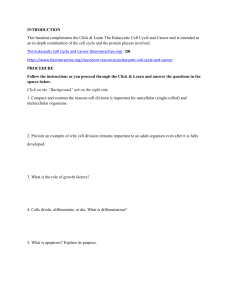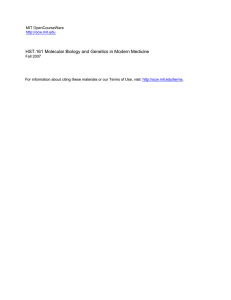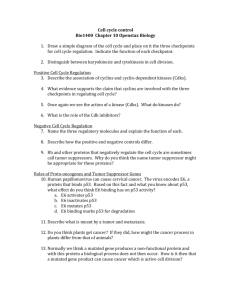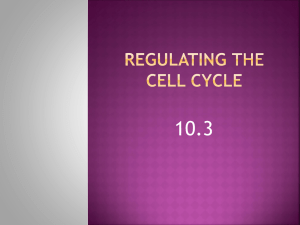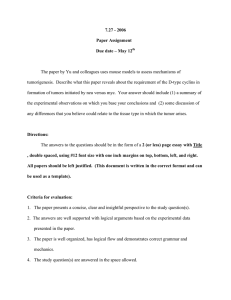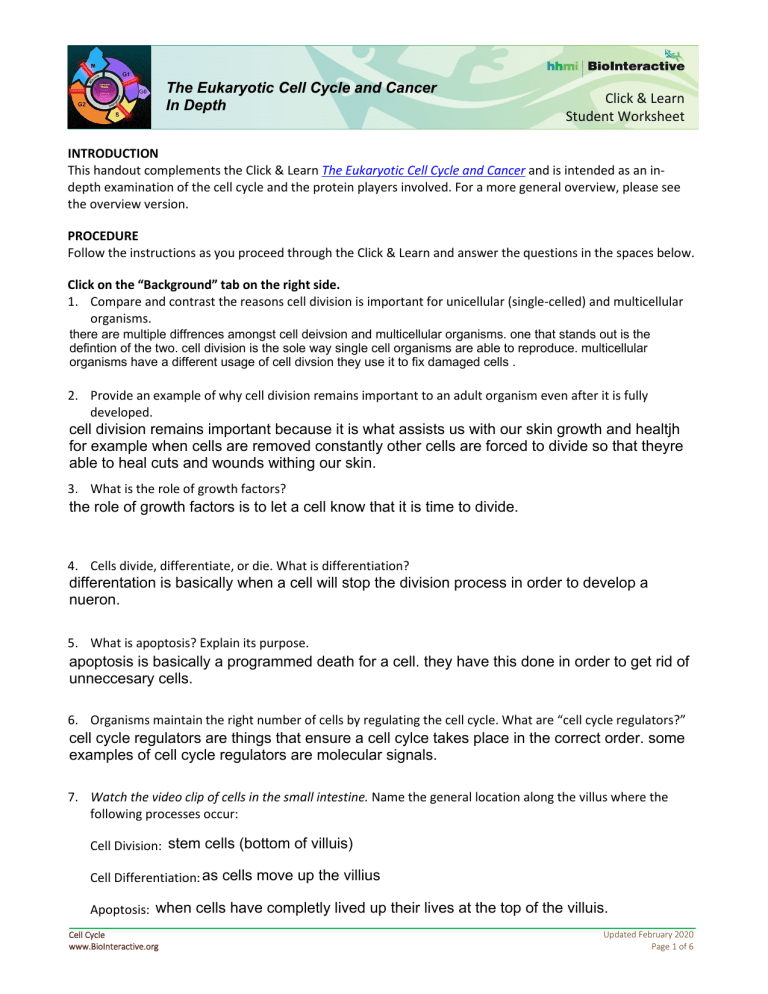
The Eukaryotic Cell Cycle and Cancer In Depth Click & Learn Student Worksheet INTRODUCTION This handout complements the Click & Learn The Eukaryotic Cell Cycle and Cancer and is intended as an indepth examination of the cell cycle and the protein players involved. For a more general overview, please see the overview version. PROCEDURE Follow the instructions as you proceed through the Click & Learn and answer the questions in the spaces below. Click on the “Background” tab on the right side. 1. Compare and contrast the reasons cell division is important for unicellular (single-celled) and multicellular organisms. there are multiple diffrences amongst cell deivsion and multicellular organisms. one that stands out is the defintion of the two. cell division is the sole way single cell organisms are able to reproduce. multicellular organisms have a different usage of cell divsion they use it to fix damaged cells . 2. Provide an example of why cell division remains important to an adult organism even after it is fully developed. cell division remains important because it is what assists us with our skin growth and healtjh for example when cells are removed constantly other cells are forced to divide so that theyre able to heal cuts and wounds withing our skin. 3. What is the role of growth factors? the role of growth factors is to let a cell know that it is time to divide. 4. Cells divide, differentiate, or die. What is differentiation? differentation is basically when a cell will stop the division process in order to develop a nueron. 5. What is apoptosis? Explain its purpose. apoptosis is basically a programmed death for a cell. they have this done in order to get rid of unneccesary cells. 6. Organisms maintain the right number of cells by regulating the cell cycle. What are “cell cycle regulators?” cell cycle regulators are things that ensure a cell cylce takes place in the correct order. some examples of cell cycle regulators are molecular signals. 7. Watch the video clip of cells in the small intestine. Name the general location along the villus where the following processes occur: Cell Division: stem cells (bottom of villuis) Cell Differentiation: as cells move up the villius Apoptosis: when cells have completly lived up their lives at the top of the villuis. Cell Cycle www.BioInteractive.org Updated February 2020 Page 1 of 6 Click & Learn Student Worksheet The Eukaryotic Cell Cycle and Cancer – In Depth 8. Name one harmless result of too little cell division. a harmless result of too little cell division would be hair loss . not extreme but some . 9. Name one harmless result of too much cell division. one harmless result of too much cell division may be gaining some warts. Click on the section of the circle labeled “Cell Cycle Phases” in the center purple circle on the right and use the “Overview” information in the window on the left to answer the questions below. 10. List, in order, the four events we collectively call the “cell cycle.” Next to each event, write the correlating cell cycle phase name. a. G1 phase b. the S phase c. G2 phase d. the M phase 11. In general, what is the purpose of a checkpoint in the cell cycle? The purpose of a checkpoint in the cell cycle is to ensure the cells health and ability to complete the cell cycle. 12. What is one potential outcome when errors occur in this highly regulated cell cycle process? a pottetial outcome when error occur in this higly regulated cell cycle process would be cancer. Click on “Cell Cycle Regulators and Cancer” in the center purple circle on the right. Use the information under “Regulators Overview” in the window on the left to answer the questions below. 13. What type of protein that regulates the cell cycle is encoded by proto-oncogenes? a type of protien that regulates the cell cycle and is encoded by protooncogenes would be protiens that stiulate the cell cycle. 14. What type of protein that regulates the cell cycle is encoded by tumor suppressor genes? protiens that inhibit the cell cycle. CDKs 15. The most important cell cycle regulators are the ______________________________________ . 16. What is a kinase, and what does it do? Kinases are enzymes that phosphorylate other proteins and activate and inhibit them. 17. When are CDKs present inside the cell during the cell cycle? cdks are always present in the cell 18. When are cyclins present inside the cell during the cell cycle? depending on the phase of the cycle then cyclins concentration inside the cell cycles up and down. Cell Cycle www.BioInteractive.org Updated February 2020 Page 2 of 6 Click & Learn Student Worksheet The Eukaryotic Cell Cycle and Cancer – In Depth 19. CDKs form molecular complexes with cyclins. What do activated CDK-cyclin complexes do? cyclins are present inside the cell during the cell cycle when the cell is moving toward division Using the cell cycle diagram on the right and both links in the center purple circle, complete the table below for each phase. Use bullet points and focus on major events that occur during each phase, checkpoint, and regulatory process. Complete the entire row before moving on to the next phase. PHASE PHASE EVENTS CHECKPOINT EVENTS the cell grows checks for damage in the cell. checks avaliabilty to go through the other phases. replicates dna checks for errors cell continues to grow checks chromosomes and ensures cell is prepared to divide the cell divides makes sure everything is connected and good G1 REGULATORY PROCESSES need help with this collom dont understand what you mean completely. S G2 M (mitosis) 20. Go to “Cell Cycle Phases” and click on “Interphase.” The interphase alternates with mitosis. What happens during interphase and what phases does it include? during interphase the cell grows and replicates the phases that are included are G1 ,G2, and the S phase. 21. Go to “Cell Cycle Phases” and click on “G0.” The G0 phase is a resting or nondividing stage. What three factors determine if a cell enters G0? confused for this question. Cell Cycle www.BioInteractive.org Updated February 2020 Page 3 of 6 The Eukaryotic Cell Cycle and Cancer – In Depth Click & Learn Student Worksheet 22. Provide an example of a fully differentiated cell that is (a) permanently in G0 and (b) one that can leave G0 to progress through the cell cycle and divide again. a. nuerons b. liver cells Click on “Cell Cycle Regulators and Cancer” in the center purple circle on the right. Then click on the “Cancer Overview” tab in the window to the left (right tab). 23. Cancer is an improperly regulated cell cycle. Name two reasons why cells can form tumors. this could possibly happen due to too little cell division or too much cell division occuring 24. What causes uncontrolled cell division at the genetic level? mutations 25. Watch the video clip. At the cellular level in this example, explain what occurs if the APC gene is mutated. if this happens then cells will continue dividing causing cancer to come. 26. Normally, proto-oncogenes stimulate the cell cycle. What do mutated proto-oncogenes (i.e., oncogenes) cause? cancer 27. Normally, tumor suppressor genes inhibit the cell cycle. What do mutated tumor suppressor genes cause? cancer 28. To cause cancer, proto-oncogenes require ___ 1 (or) ___ 2 allele(s) to be mutated and are therefore considered ___ dominant (or) ___ recessive. This results in a ___________ of function. 29. To cause cancer, tumor suppressor genes require ___ 1 (or) ___ 2 allele(s) to be mutated and are therefore considered ___ dominant (or) ___ recessive. This results in a ___________ of function. 30. Watch the video clip. a. Using the gas pedal analogy, explain the impact on the cell cycle of a proto-oncogene versus an oncogene. much like a gas pedal the proto oncogene enhances or makes the cycle move forward. when oncogene produces then its basically charging the car forward entirely too fast. b. Using the brake pedal analogy, explain the impact on the cell cycle of one mutated tumor suppressor gene allele versus two mutated tumor suppressor alleles. tumor supressers are basically the brakes in these analagy they basically slow down or stop before the bad can happen . Cell Cycle www.BioInteractive.org Updated February 2020 Page 4 of 6 The Eukaryotic Cell Cycle and Cancer – In Depth Click & Learn Student Worksheet ADVANCED EXTENSION QUESTIONS (OPTIONAL) Now that you have finished the Click & Learn, use your knowledge to answer the following questions. 31. p53 is a protein that is encoded by a tumor suppressor gene, and some scientists refer to it as “the guardian of the genome.” a. Explain its normal role and why scientists would regard it as the “guardian of the genome.” b. Explain what happens to the cell cycle if both alleles of the gene encoding p53 are mutated. 32. Explain why people who inherit one mutated allele of the BRCA1 gene have a higher likelihood of developing cancer. 33. Predict a potential outcome of a mutated mitotic arrest deficient (MAD) protein. 34. Use the model illustrated in the figure below to answer the accompanying questions. Cell Cycle www.BioInteractive.org Updated February 2020 Page 5 of 6 The Eukaryotic Cell Cycle and Cancer – In Depth Click & Learn Student Worksheet a. The human gene EGFR located on chromosome 7 is a proto-oncogene that codes for a growth factor cell surface receptor. The binding of growth factors to this receptor can lead to cell proliferation. Hypothesize what potential impact a mutated EGFR allele will have on a cell. Give one possible impact and explain your answer. b. RAS is a G protein that is activated when a growth factor attaches to EGFR. Its activation results in the exchange of GTP for GDP. Once activated, the GTP cannot be hydrolyzed and RAS cannot be deactivated What is one potential outcome of a mutation in one of the two copies of RAS? c. Mutations in the genes that code for proteins in this pathway have been linked to various types of cancer (i.e., RAS: pancreatic, BRAF: colorectal, MEK: melanoma, EGFR: lung). If you were developing a new cancer drug, what would be an appropriate target protein for the new drug therapy? Justify your answer. Cell Cycle www.BioInteractive.org Updated February 2020 Page 6 of 6
